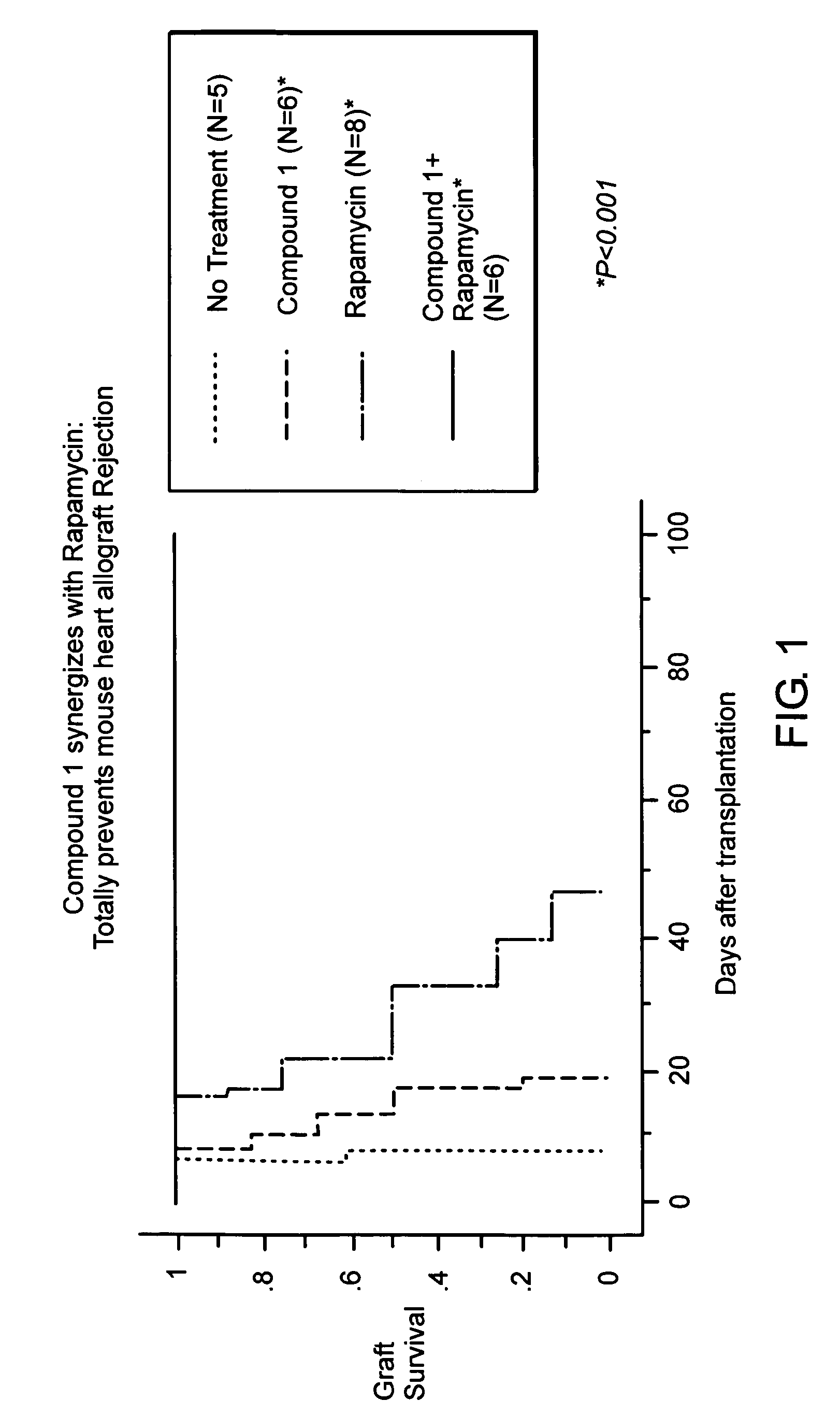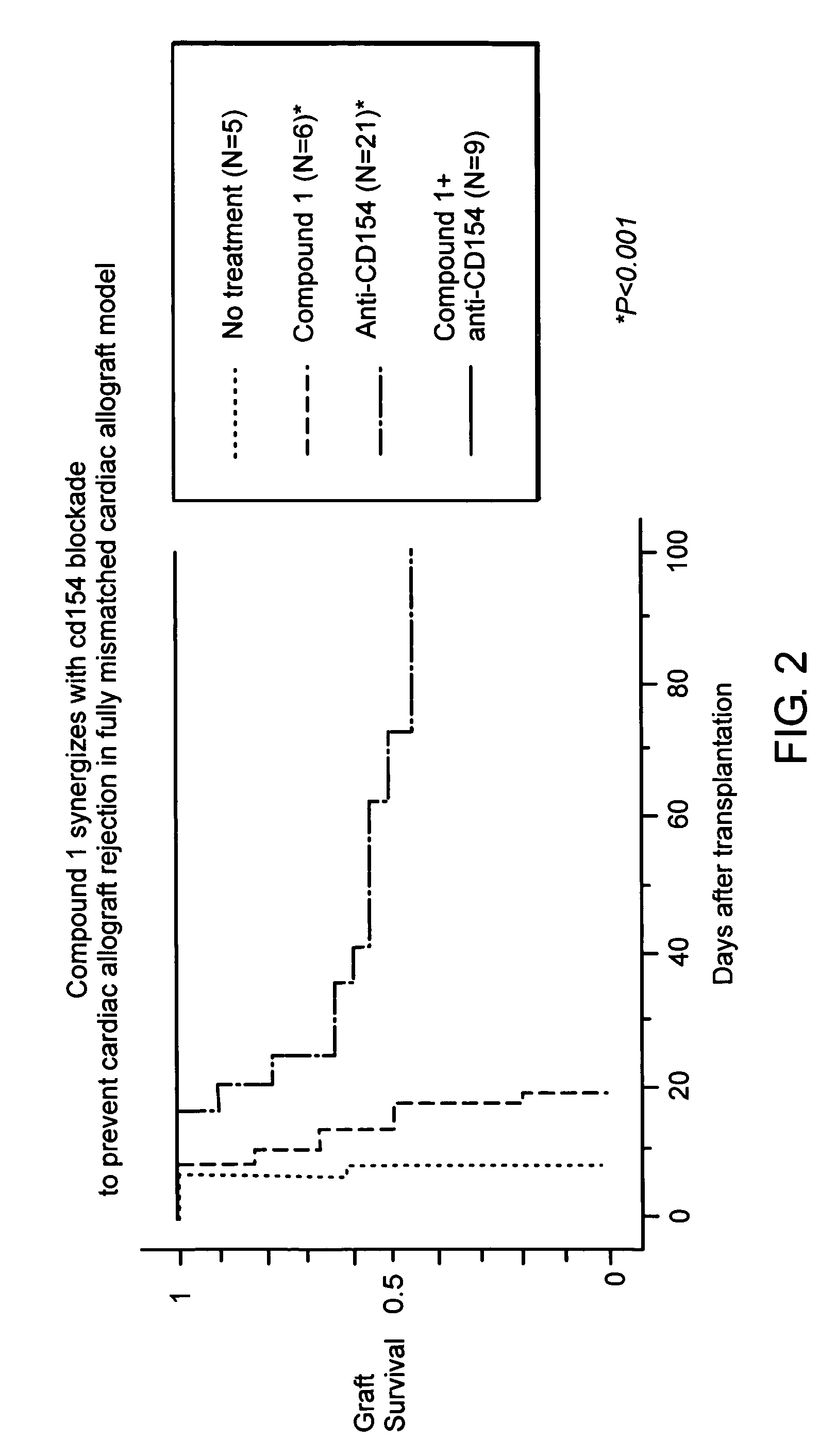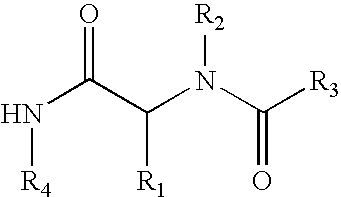Induction of immune tolerance
a technology of immune tolerance and tolerance, applied in the field of immune tolerance induction, can solve the problems of destroying the transplant, affecting the transplantation process, so as to induce specific immune tolerance, suppress the rejection of organ transplants, and induce tolerance.
- Summary
- Abstract
- Description
- Claims
- Application Information
AI Technical Summary
Benefits of technology
Problems solved by technology
Method used
Image
Examples
example 1
Synergistic Suppression of Transplant Rejection Using a Combination Therapy of Compound 1 and Rapamycin in a Mouse Model
[0092]The ability of a combination therapy of rapamycin and Compound 1 to inhibit transplant rejection in a mouse model was tested. Specifically, the heart from C57 / BL6 mice was transplanted into Balb / c recipient mice (total MHC mismatch) using standard protocol described in Hancock, W. W., et al. and Yuan et al., Transplantation 73: 1736, Proc. Natl. Acad. Sci. USA 93: 13967 (1996), the entire teachings of which are incorporated herein by reference. Following surgery, the mice were divided into the following treatment groups:[0093]Group I is a control group that was untreated.[0094]Group II was treated with Compound 1 at a dose of 75 mg / kg / day subcutaneously for fourteen days following surgery.[0095]Group III was treated with rapamycin at a dose of 0.3 mg / kg / day intraperitoneally for three days following surgery.[0096]Group IV was treated with Compound 1 at a dose...
example 2
Synergistic Suppression of Transplant Rejection Using a Combination Therapy of Compound 1 and Anti-CD40L in a Mouse Model
[0097]The ability of a combination therapy of anti CD40L and Compound 1 to inhibit transplant rejection in a mouse model was tested according to the protocol of Example 1 using a single 250 μg dose of anti CD40L administered intraperitoneally in place of rapamycin. The results are shown in FIG. 2. As can be seen, mice receiving the combination therapy had 100% graft survival for over 100 days, indicating that the two drugs acted synergistically (p<0.001). Again, the animals treated in this manner never showed signs of acute rejection and were sacrificed at 120 days following surgery so that the transplanted heart could analyzed histologically.
example 3
Induction of Specific Immune Tolerance Using a Combination Therapy of the Compound 1 and Rapamycin in a Mouse Model
[0098]The ability of a combination therapy of rapamycin and the Compound 1 to induce specific immune tolerance in a mouse model was tested. Specifically, the heart from C57 / BL6 mice was transplanted into Balb / c recipient mice (total MHC mismatch) using standard protocol described in Hancock, W. W., et al. Proc. Natl. Acad. Sci. USA 93: 13967 (1996) and and Yuan et al., Transplantation 73:1736. Following surgery, the mice were treated with the Compound 1 at a dose of 75 mg / kg / day intraperitoneally for fourteen days and with rapamycin at a dose of 0.3 mg / kg / day intraperitoneally for three days. Following treatment, the mice were divided into two groups of 2 mice each. The first group received a second transplanted heart from the same donor strain of mice; mice from the second group received a second heart transplant from an unrelated third party donor. The hearts from the...
PUM
| Property | Measurement | Unit |
|---|---|---|
| Immunogenicity | aaaaa | aaaaa |
Abstract
Description
Claims
Application Information
 Login to View More
Login to View More - R&D
- Intellectual Property
- Life Sciences
- Materials
- Tech Scout
- Unparalleled Data Quality
- Higher Quality Content
- 60% Fewer Hallucinations
Browse by: Latest US Patents, China's latest patents, Technical Efficacy Thesaurus, Application Domain, Technology Topic, Popular Technical Reports.
© 2025 PatSnap. All rights reserved.Legal|Privacy policy|Modern Slavery Act Transparency Statement|Sitemap|About US| Contact US: help@patsnap.com



